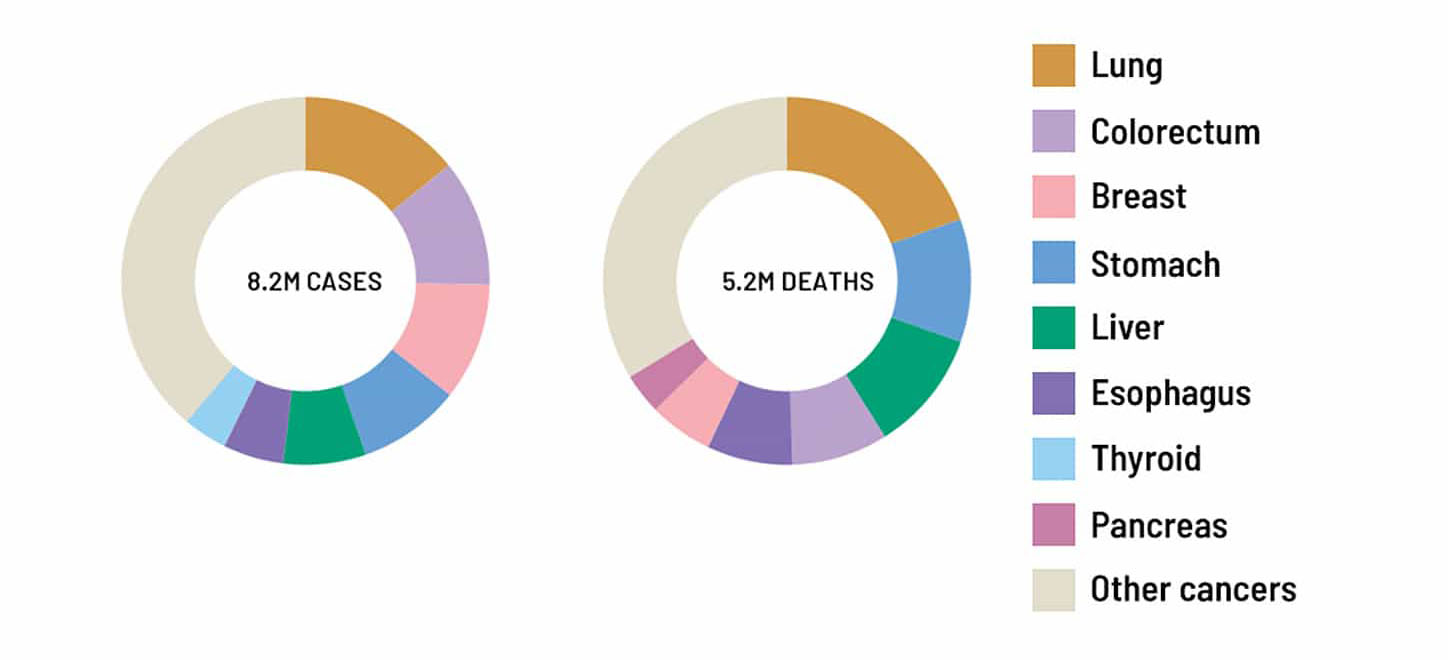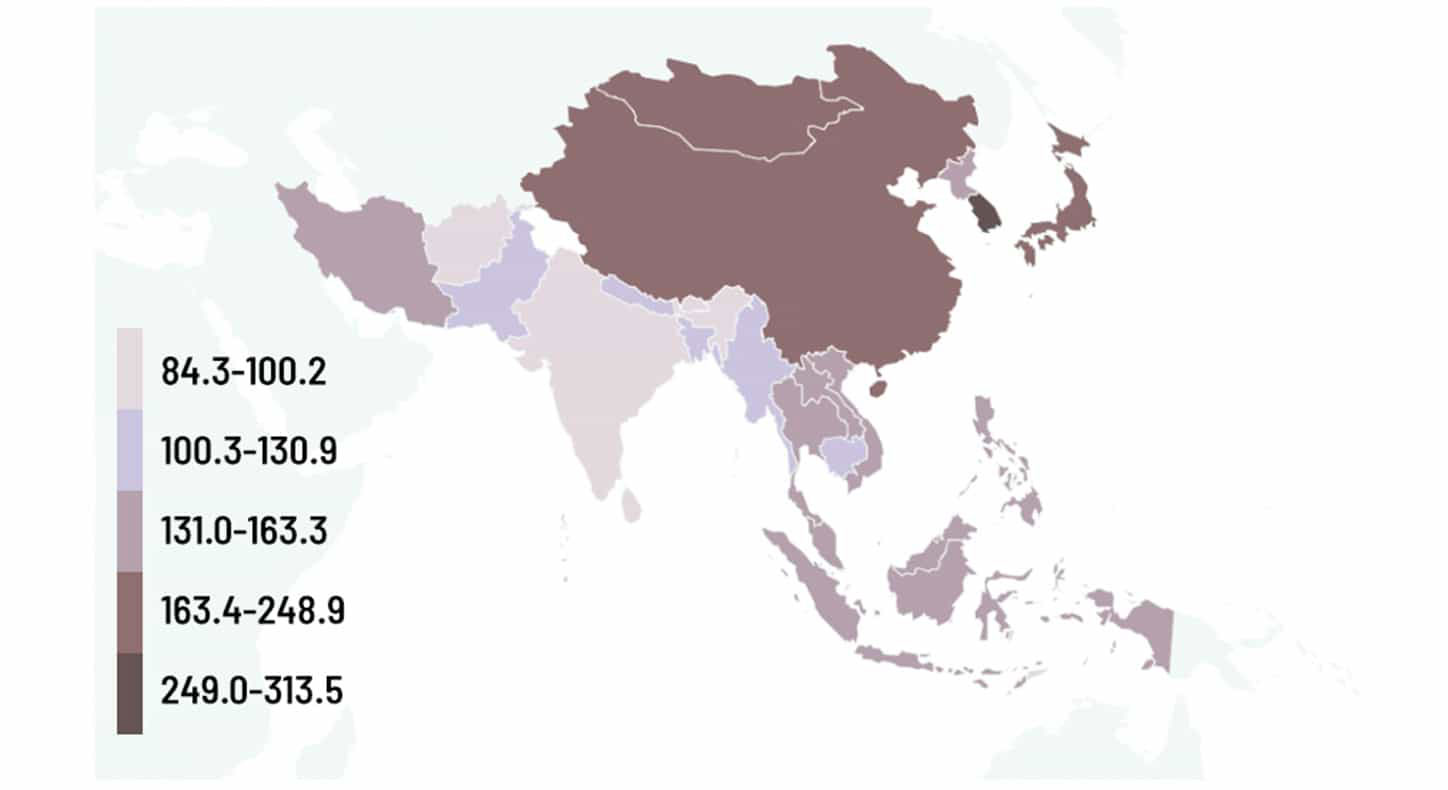
Cancer Burden & Prevention Information for SE Asia
Globally, 1 in 6 deaths are cancer related [1].
8.2 million new cancer cases and 5.2 million cancer deaths were estimated in Southern, Eastern, and South-Eastern Asia in 2018, the majority of which were in China. Although cancer rates vary from country to country, this region alone corresponds to approximately half of the cancer burden worldwide [2].
All cancer sites combined incidence rates in Southern, Eastern, and South-Eastern Asia, age-standardized rate (world) per 100,000, both sexes combined, 2018
Copyright © 2019 TheAmerican Cancer Society, Inc.
All rights reserved
Lung, colorectal, and breast cancer are the most common in the region, while lung, stomach, and liver cancer are the leading cause of death [2].
Estimated number of new cancer cases vs. deaths and distribution (%) by type (excludes non-melanoma skin cancer) in Southern, Easter, and South-Eastern Asia, both sexes, 2018

Copyright © 2019 The American Cancer Society, Inc.
All rights reserved
Although not all cancer is preventable, between 30-50% of cancer cases are [3]. The WHO recommends the following cancer prevention strategies:
1. Limit tobacco use & exposure to secondhand smoke
Smoking can lead to lung, oesophagus, larynx, mouth, throat, kidney, bladder, pancreas, stomach, & cervical cancer [3]. In general, tobacco is responsible for ~22% of cancer death [1].
2. Improve your diet & exercise regularly
Diets high in fruits & vegetables can protect the body from many cancers. Eating nutritious food along with regular physical activity can limit obesity, which is linked to many types of cancer, including oesophagus, colorectal, breast, endometrium, & kidney [3].
3. Control alcohol intake
Cancer risk increases with the amount of alcohol consumed. Excess alcohol can contribute to liver, colorectal, oesophagus, larynx, pharynx, & oral cavity cancer. Smoking combined with excessive drinking can significantly increase cancer risk [3].
4. Keep up with vaccinations
Approximately 15% of all cancers are associated with infections [3]. It is estimated that vaccinating against human papillomavirus (HPV) & Hepatitis B alone could prevent 1 million cancer cases each year [1].
5. Limit environmental pollution & carcinogen exposure
Outdoor air pollution is responsible for more than 200,000 lung cancer deaths worldwide. Additionally, indoor air pollution, such as cooking with coal fires, doubles the risk of lung cancer [3].
Individuals in certain work fields man also be exposed more heavily to certain carcinogens, like asbestos, which is directly related to mesothelioma (a type of lung cancer) [3].
6. Reduce exposure to radiation
UV & solar radiation cause all major types of skin cancer; sunscreen & protective clothing should be worn to limit exposure [3].
Radiation can also be used for medical reasons, but should be properly performed & deemed medically necessary to reduce any needless harm [3].
Most importantly, remember that no one knows your body better than you do. Always be alert for symptoms of disease and speak to your doctor regularly about any recommended cancer screenings.
The American Cancer Society created this helpful reminder of things to be aware of about your body [4]:
References
[1] Fact Sheet – Cancer [Internet]. World Health Organization (WHO). 2020 [cited 22 May 2020].
Available from: https://www.who.int/news-room/fact-sheets/detail/cancer
[2] Southern, Eastern,& South-Eastern Asia [Internet]. The Cancer Atlas. 2019 [cited 22 May2020].
Available from: https://canceratlas.cancer.org/the-burden/south-east-se-asia/
[3] Cancer prevention [Internet]. World Health Organization (WHO). 2020 [cited 22 May 2020].
Available from: https://www.who.int/cancer/prevention/en/
[4] Harvard Health Publishing – Harvard Medical School. The 10 commandments of cancer prevention. [Internet]. 2019 [cited 22 May 2020].
Available from: https://www.health.harvard.edu/newsletter_article/the-10-commandments-of-cancer-prevention
Disclaimer: The information provided in this article (including but not limited to the text, inks (if any) and other materials) is general information and for reference purpose only. It does not constitute and must not be used as a substitute for medical advice, diagnosis or professional advice. You should seek independent professional advice from an appropriate qualified medical professional (e.g. a doctor) before making any decision on the subject mentioned in this article. Prudential Hong Kong Limited (“Prudential”) reserves the right to change and amend the comments contained in this article at any time without any prior notice. Prudential does not make any express or implied warranty as to the fitness for a particular purpose, non-infringement in relation to such contents. Prudential will not be liable or responsible for loss or damage directly or indirectly resulting from any use or misuse of or interpretation or reliance on the information contained herein. If necessary, you should seek medical advice as soon as possible and never neglect or delay seeking medical advice/treatment.


